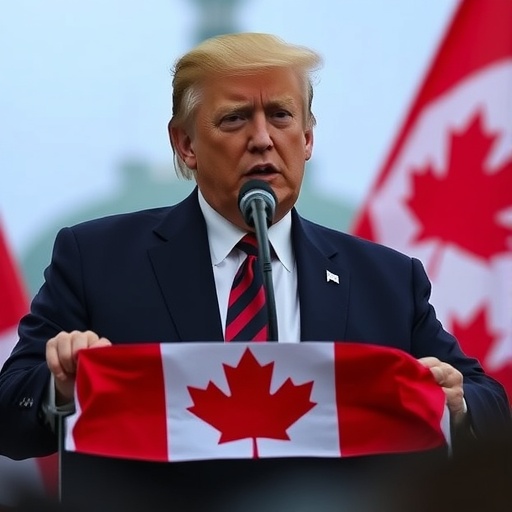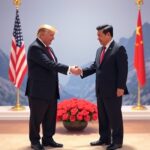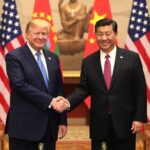Trump Escalates Trade War: New Tariffs on Canada Sparked by Critical TV Ad in Ongoing Dispute
In a bold and unexpected move, President Donald Trump has imposed steep new tariffs on Canadian imports, directly citing a provocative television advertisement from Canada that lambasted his trade policies as the catalyst. This announcement, made during a fiery White House press briefing on Wednesday, marks a significant escalation in the simmering trade dispute between the United States and its northern neighbor, threatening to upend decades of robust US-Canada relations.
- The Provocative Canadian TV Ad That Ignited Presidential Wrath
- Unpacking the New Tariffs: Scope, Rates, and Targeted Industries
- Flashback to Fractured US-Canada Relations: A History of Trade Clashes
- Voices from the Frontlines: Reactions Pour In from Leaders and Stakeholders
- Navigating the Fallout: Economic Ripples and Diplomatic Pathways Forward
The tariffs, set to take effect next month, target key sectors including lumber, dairy, and automobiles, which collectively represent billions in annual trade. Trump described the Canadian ad as “a blatant attack on American workers and fair trade,” vowing that the measures would protect US industries from what he called “unfair Canadian practices.” This development comes amid broader tensions over issues like border security and energy exports, raising fears of a full-blown trade war that could ripple through North American economies.
The Provocative Canadian TV Ad That Ignited Presidential Wrath
The spark for this latest flare-up in the US-Canada trade dispute was a 30-second television commercial aired nationwide in Canada last week by a coalition of consumer advocacy groups. Titled “America’s Trade Tantrum,” the ad featured stark imagery of shuttered US factories juxtaposed with clips of Trump signing previous tariff orders, narrated by a gravelly voiceover decrying his policies as “bullying tactics that hurt everyday families on both sides of the border.”
Produced by the Canadian Fair Trade Alliance, the spot explicitly criticized Trump’s approach to renegotiating the United States-Mexico-Canada Agreement (USMCA), accusing him of prioritizing political theater over economic stability. “When leaders play games with trade, it’s the workers who pay the price,” the ad concluded, ending with a call for Canadians to support local products amid rising US protectionism.
Trump, never one to shy away from media confrontations, reacted swiftly on social media, tweeting, “Canada thinks they can run smear ads against me? Time to hit back where it hurts—their wallet! Tariffs coming fast!” His response has polarized opinions, with supporters praising his defense of American interests and critics warning of retaliatory measures that could harm US exporters.
According to Nielsen ratings data, the ad reached over 5 million Canadian households in its first airing, amplifying its impact and drawing international attention. Canadian Prime Minister Justin Trudeau, when asked about the commercial during a press conference in Ottawa, distanced his government from it, stating, “This is the voice of civil society, not official policy. But trade must be fair for all.”
Unpacking the New Tariffs: Scope, Rates, and Targeted Industries
The tariffs announced by Trump impose a 25% duty on Canadian softwood lumber—a longstanding point of contention—and a 15% levy on dairy products, which Trump claims are subsidized to undercut US farmers. Additionally, a 10% tariff on auto parts and vehicles crossing the border aims to address what the administration calls “dumping” practices. These measures are projected to affect approximately $20 billion in annual Canadian exports to the US, based on 2023 trade figures from the US Census Bureau.
Under the USMCA, which replaced NAFTA in 2020, such unilateral actions were intended to be rare, requiring consultations through the agreement’s dispute resolution mechanisms. However, Trump’s team argues that the ad constitutes “propaganda that distorts trade facts,” justifying the bypass of standard protocols. Commerce Secretary Wilbur Ross elaborated in a statement, “This isn’t retaliation; it’s reciprocity. Canada has targeted our industries before—now it’s their turn to feel the pinch.”
Economists estimate the immediate cost to Canadian exporters could exceed $4 billion in the first year, with US consumers facing higher prices for everything from maple syrup to minivans. The US International Trade Commission reports that Canada supplies 18% of US lumber imports and 12% of dairy, making these tariffs particularly disruptive. In a related statistic, bilateral trade between the US and Canada totaled $680 billion in 2022, underscoring the high stakes involved.
Industry leaders are already mobilizing. The Canadian Vehicle Manufacturers’ Association warned that the auto tariffs could add $1,000 to the price of a new car in the US, potentially slowing sales amid inflation concerns. Meanwhile, US lumber producers, represented by the National Association of Home Builders, have mixed reactions—some applaud the protection, while others fear supply chain disruptions that could drive up housing costs by 5-7%.
Flashback to Fractured US-Canada Relations: A History of Trade Clashes
This isn’t the first time tariffs have strained US-Canada relations under Trump. During his first term, he slapped 25% tariffs on Canadian steel and 10% on aluminum in 2018, citing national security—a move that prompted swift Canadian retaliation with duties on US whiskey, yogurt, and ketchup. Those measures were eventually lifted after intense negotiations, but they left scars on the bilateral relationship.
Fast-forward to the USMCA era, disputes over dairy market access and digital trade rules have persisted. In 2021, a World Trade Organization panel ruled against Canada in a case brought by the US over milk pricing, awarding Trump a partial victory. Yet, the current trade dispute feels more personal, triggered by a media campaign rather than policy disagreements.
Historical data from the Office of the US Trade Representative shows that US-Canada trade has grown 300% since the 1994 NAFTA implementation, fostering integrated supply chains in sectors like aerospace and energy. Alberta’s oil sands, for instance, supply 60% of US crude imports from Canada, a dependency that could complicate any escalation. Trump’s rhetoric echoes his 2016 campaign promises to overhaul trade deals, but analysts note that previous spats cost the US economy an estimated $3 billion in lost exports due to Canadian countermeasures.
Experts like trade scholar Jennifer Hillman from the Council on Foreign Relations point out, “Trump’s tariff strategy is impulsive, often ignoring long-term alliances. This ad may have been the excuse, but the underlying issues—subsidies and quotas—have festered for years.” Her commentary highlights how this episode fits into a pattern of using tariffs as leverage in broader geopolitical maneuvering, including pressures on Canada to align more closely with US stances on China and NATO contributions.
Voices from the Frontlines: Reactions Pour In from Leaders and Stakeholders
The announcement has elicited a chorus of responses, from outrage in Ottawa to cautious optimism among Trump’s base. Canadian Foreign Minister Mélanie Joly condemned the tariffs as “disproportionate and damaging,” pledging to explore WTO challenges and potential countermeasures. “US-Canada relations are built on partnership, not pettiness,” she said in a televised address, urging Trump to reconsider before implementation.
On the US side, Senate Majority Leader Chuck Schumer called the move “short-sighted,” warning it could alienate a key ally at a time when global supply chains are fragile. Conversely, House Republican Leader Kevin McCarthy defended Trump, stating, “Canada’s ad was a direct shot at our president and our economy—tariffs level the playing field.”
Business voices are equally divided. The US Chamber of Commerce, representing over 3 million businesses, issued a statement expressing concern over “unintended consequences for American jobs,” citing a potential loss of 50,000 positions in export-dependent sectors. Canadian lumber giant West Fraser Timber Co. Ltd. saw its shares drop 8% in Toronto trading following the news, with CEO Ray Ferris telling Bloomberg, “This hits at the heart of our operations—we’ll fight it every step.”
Public opinion polls reflect the divide: A recent Angus Reid survey in Canada showed 62% of respondents viewing the tariffs as unfair, while a Fox News poll indicated 55% of Americans support Trump’s tough stance on trade. Environmental groups, like the Sierra Club, have also weighed in, arguing that lumber tariffs could inadvertently boost logging in less-regulated areas, exacerbating deforestation concerns along the border.
Navigating the Fallout: Economic Ripples and Diplomatic Pathways Forward
As the dust settles on Trump’s tariff declaration, the economic implications for US-Canada relations are profound and multifaceted. Modeling from the Peterson Institute for International Economics predicts a 0.5% GDP dip for Canada in 2024 if tariffs persist, with the US facing a milder 0.2% hit due to its larger economy—but that’s cold comfort for border states like Michigan and New York, which rely heavily on Canadian trade.
Inflationary pressures could mount, with the Federal Reserve already monitoring the situation. US dairy farmers, for example, might benefit from reduced competition, but consumers could see milk prices rise by 10-15%, per USDA estimates. In autos, the integrated North American manufacturing hub—where parts cross the border multiple times—risks bottlenecks, potentially delaying production for giants like Ford and GM.
Diplomatically, the next steps hinge on bilateral talks. The USMCA’s joint committee is scheduled to meet in two weeks, where Canadian negotiators plan to push for exemptions. Trump has hinted at flexibility, tweeting, “If Canada pulls that ad and plays fair, we can talk.” Yet, with midterm elections looming, political posturing may prolong the standoff.
Looking ahead, resolving this trade dispute could redefine US-Canada relations for years to come. Analysts foresee possible concessions, such as Canada increasing US energy purchases or easing dairy quotas, in exchange for tariff relief. Broader implications include strained alliances in forums like the G7, where unity on issues like climate and security is vital. As one Brookings Institution report notes, “Tariffs may win headlines, but sustainable trade requires dialogue—not division.” Stakeholders on both sides are bracing for negotiations that could either mend fences or deepen the rift, with the global economy watching closely.








